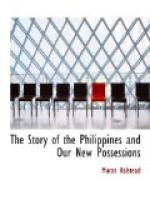The streets are wider than in the older part of Havana, and will admit two carriages abreast. The sidewalks are narrow, and in places will accommodate but one person. The pavements are of a composition manufactured in England from slag, pleasant and even, and durable when no heavy strain is brought to bear upon them, but easily broken, and unfit for heavy traffic. The streets are swept once a day by hand, and, strange to say, are kept very clean.
From its topographical situation the town should be healthy, but it is not. The soil under the city is clay mixed with lime, so hard as to be almost like rock. It is consequently impervious to water and furnishes a good natural drainage.
The trade wind blows strong and fresh, and through the harbor runs a stream of sea water at a speed of not less than three miles an hour. With these conditions no contagious diseases, if properly taken care of, could exist; without them the place would be a veritable plague spot.
Besides the town within the walls there are small portions just outside, called the Marina and Puerta de Tierra, containing two or three thousand inhabitants each. There are also two suburbs, one, San Turce, approached by the only road leading out of the city, and the other, Catano, across the bay, reached by ferry. The Marina and the two suburbs are situated on sandy points or spits, and the latter are surrounded by mangrove swamps.
The entire population of the city and suburbs, according to the census of 1887, was 27,000. It is now (1896) estimated at 30,000. One-half of the population consists of negroes and mixed races.
There is but little manufacturing, and it is of small importance. The Standard Oil Company has a small refinery across the bay, in which crude petroleum brought from the United States is refined. Matches are made, some brooms, a little soap, and a cheap class of trunks. There are also ice, gas, and electric light works.
CHAPTER XXVI
The Ladrones.
The Island of Guam a Coaling Station of the United States—Discovery, Size and Products of the Islands.
When the Philippine expedition on its way to Manila incidentally ran up the Stars and Stripes over the Island of Guam, there was perhaps no thought of the island becoming a permanent part of our domain. However, the fortunes of war are such that the island is likely to become ours permanently as a coaling station in the Pacific.
Magellan named these islands the Ladrones from the Latin word “latro,” meaning a robber, because of the thievish propensities of the natives. According to Magellan’s reports, the native people of these islands had reduced stealing to a science of such exactness that the utmost vigilance could not prevail against their operations. The group was named the Mariana Islands by the Jesuits, who settled in them in 1667.




